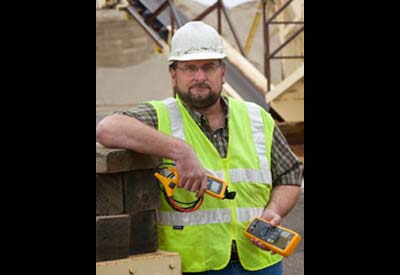Étude de cas : S’éloigner d’un risque d’arc électrique

« Ce jour-là, nous commencions à voir que nous avions plus de problèmes avec notre ventilateur d’extraction sur le filtre à poussière. Le ventilateur avait deux moteurs de 100 chevaux-vapeur. Nous voyions les surtensions sur l’un des moteurs et on assumait que nous avions un mauvais moteur. Nous l’avions changé et il continuait de mal fonctionner. Nous faisions des diagnostiques et retournions vérifier l’ampérage pour voir quelle phase causait le problème. Nous avons alors mis en marche le Fluke CNX. La première fois que nous avons appuyé sur le bouton départ après la mise en marche du nouveau système, il y a eu explosion.
Nous étions dans la salle des commandes des moteurs. Nous avons tous cette pièce. Nous avons demandé à l’opérateur de l’usine d’aller de l’avant et de mettre le ventilateur en marche. Dès que le bouton départ du ventilateur a été actionné, nous avons entendu le souffle d’une explosion venant de la salle des commandes. Quelque chose avait brûlé ou flambé. Je me suis aussitôt dit que j’étais heureux qu’il n’y ait eu personne dans la pièce. Nous pouvions lire le rapport sans être dans la pièce. »
http://support.fluke.com/find-sales/Download/Asset/6003054_6003_ENG_A_W.PDF
Case Study: Stepping Away From An Arc Flash Hazard
Jeff Conover: “Something had burned up, or flashed. My first thought was I was glad nobody was in the room. My second thought was the CNX…did what it was supposed to do.”
It was a pesky glitch: an intermittent problem that tripped the breaker and interrupted the 480 V power to one of two 100-horsepower fan motors driving the dust filtration system at an Ohio asphalt plant.
But not a major safety problem. At least that’s how it looked.
For Jeff Conover, asphalt performance manager for Oldcastle Materials, the job was to find the cause and get the plant running right.
Safety topped Conover’s expectations as he and plant foreman and electrician Charlie West locked and tagged-out the motor control centre and set up their tests. And the team had a safety advantage: a Fluke CNXTM Wireless Test System (this product has been replaced by Fluke ConnectTM).
“On that day we were starting to get more problems on our exhaust fan on the bag house (dust filter),” Conover said. “The exhaust fan has two 100 horsepower motors on it. We were tripping the overloads on one of the motors. We assumed that we had a bad motor. We had changed the motor and it still continued after we megged it out. We kept diagnosing and we were going to check the amps to see which phase was causing the trips. That was when we put the Fluke CNX System on. And the next time we hit the start button the explosion happened.”
Explosion?
“We were standing in the control house,” he said. “We had all stepped out of the motor control centre. We asked the plant operator to go ahead and start the exhaust fan. As soon as he hit the start button a small shotgun blast back from the control centre sounded. Something had burned up, or flashed. My first thought was I was glad nobody was in the room.
“My second thought was the CNX, even though we didn’t get any readings, did what it was supposed to do. We were able to leave the motor control centre room and step around the corner with the CNX because we were able to read the metre without being in that location.”
Because the team had stepped out of the room and were 15 feet away they didn’t see the arc flash, but the damage when they returned was obvious.
“The weakest link in our circuit was the thermal overloads in the motor control centre,” Conover said. “When that shorted it caused that thermal overload section of the motor starter to literally blow up and explode. It actually burned the overloads themselves into multiple pieces. The thermal overload had to be completely replaced before we had the chance to run it again.”
Cause, luck, and preparation
“We found that the motor lead cable going out to the motor, probably 75 to 100 feet (22.8 to 30.4 meters) away from the control house, had shorted internally from one phase to ground… causing the arc flash that happened back inside the motor control centre,” Conover said. Tracing along the cable, the team found a hot spot under the insulation where the short occurred. Conover estimates the failed cable, located outdoors, at 20-plus years old.
The timing of the short Conover attributes to luck — it just happened to occur while testing was underway. The fact no one was injured? That came from good safety practices and using the right gear.
“It was just luck as to the time that it did happen,” he said. “It also gives you an understanding that even though the short was 100 feet away, it doesn’t mean that’s where the arc flash was going to happen. It happens at the weakest link, and we don’t always know where that weak link is.”
Source: Fluke Digital Library @ www.fluke.com/library.










